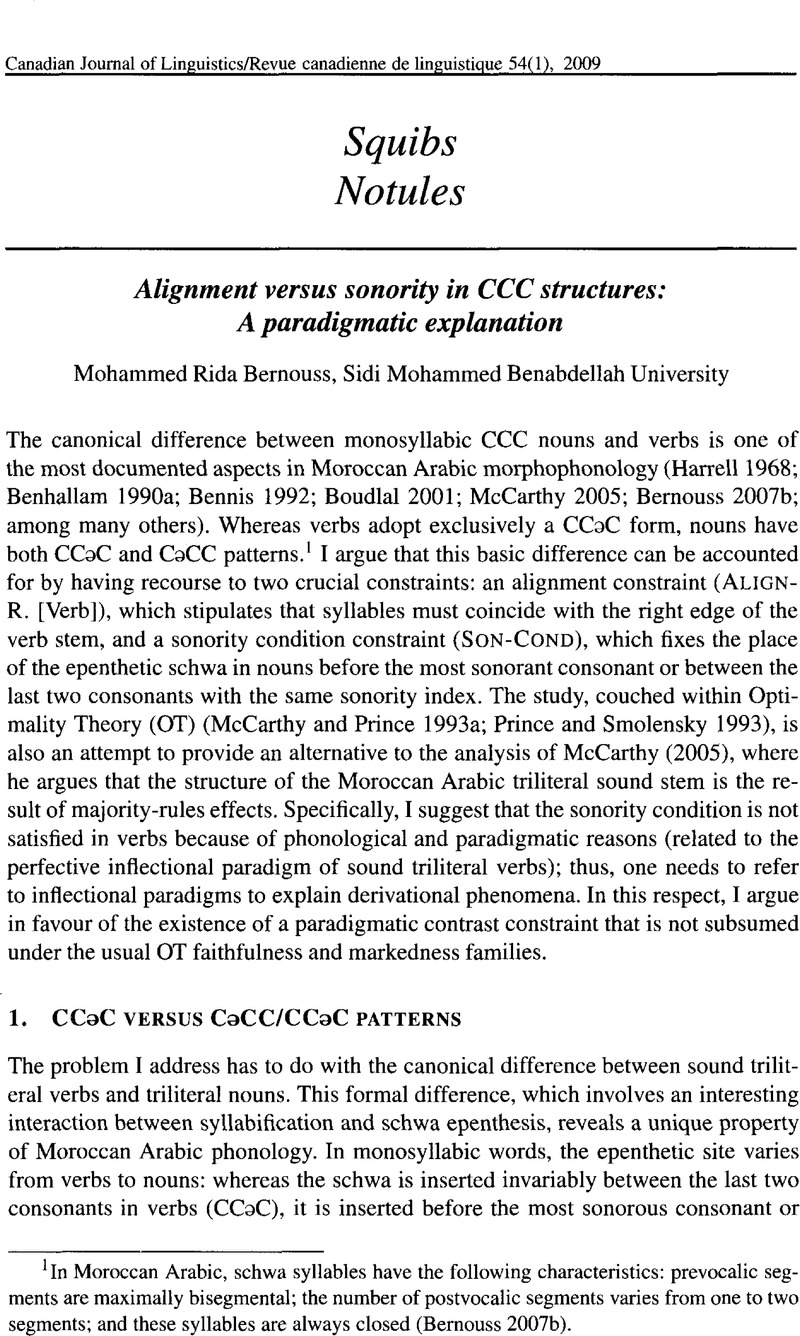No CrossRef data available.
Article contents
Alignment versus sonority in CCC structures: A paradigmatic explanation
Published online by Cambridge University Press: 27 June 2016
Abstract
An abstract is not available for this content so a preview has been provided. Please use the Get access link above for information on how to access this content.

- Type
- Squibs/Notules
- Information
- Canadian Journal of Linguistics/Revue canadienne de linguistique , Volume 54 , Issue 1 , March 2009 , pp. 157 - 166
- Copyright
- Copyright © Canadian Linguistic Association/Association canadienne de linguistique 2009
References
Alderete, John. 1999. Dominance effects as
transderivational anti-faithfulness.
Phonology
18:201–253.10.1017/S0952675701004067Google Scholar
Al Ghadi, Abdellatif. 1990. Moroccan Arabic plurals and the organization
of the Lexicon. Doctoral dissertation, Mohammed V
University, Rabat,
Morocco.Google Scholar
Basri, Hassan, Broselow, Ellen, Finer, Daniel, and Selkirk, Elisabeth. 1998. Morphologically grounded affix classes: The
case of Makassarese. Ms., State University of New
York at Stony Brook, and University of Massachusetts at
Amherst.Google Scholar
Benhallam, Abderrafi. 1990. Moroccan Arabic syllable
structure. In Langues et
littératures
VIII:177–191. Rabat,
Morocco: Faculty of
Letters.Google Scholar
Bennis, Said. 1992. La formation du causatif en Arabe
Marocain. Doctoral dissertation, Mohammed V
University, Rabat,
Morocco.Google Scholar
Benua, Laura. 1995. Identity effect in morphological
truncation. In University of Massachusetts
occasional papers in linguistics: Papers in Optimality Theory, ed.
Beckman, Jill, Dicky, Laura Walsh and Urbanczyk, Suzanne, 77–136. Amherst,
MA: GLSA
publications.Google Scholar
Benua, Laura. 1997. Transderivational identity: Phonological
relations between words. Doctoral dissertation,
University of Massachusetts,
Amherst.Google Scholar
Bernouss, M. Rida. 2007a. A moraic approach to syllables:
Evidence from Moroccan Arabic.
Iranian Journal of Language Studies
1:155–169.Google Scholar
Bernouss, M. Rida. 2007b. Moroccan Arabic syllable
structure.
Lingua et Linguistica
1:91–106.Google Scholar
Boudlal, Abdelaziz. 2001. Constraint interaction in the phonology and
morphology of Casablanca Moroccan Arabic. Doctoral dissertation,
Mohammed V University, Rabat,
Morocco.Google Scholar
Burzio, Luigi. 1996. Surface constraints vs. underlying
representations. In Current trends in phonology:
Models and methods, ed. Durand, Jacques and Laks, Bernard, 123–142.
Manchester: European Studies
Research Institute and University of
Salford.Google Scholar
Crosswhite, Katherine. 1999. Intra-paradigmatic homophony avoidance in
two dialects of Slavic. Ms., University of
California at Los Angeles.Google Scholar
Harrell, Richard. 1962. A short reference grammar of Moroccan
Arabic. Washington, DC:
Georgetown University
Press.Google Scholar
Kager, René. 1999. Surface opacity of metrical structure
in Optimality Theory. In The derivational residue in
phonological Optimality Theory, ed. Hermans, B. and Oostendorp, M. van, 207–245.
Amesterdam: John
Benjamin.Google Scholar
Kenstowicz, Michael. 1996. Base-identity and uniform exponence:
Alternatives to cyclicity. In Current trends in
phonology: Models and methods, ed. Durand, Jacques and Laks, Bernard, 363–394.
Manchester: European Studies
Research Institute, University of Salford.Google Scholar
Kenstowicz, Michael. 2005. uniformity and
contrast. In Paradigms in phonological
theory, ed. Downing, Laura, Hall, Tracy Alan, and Raffelsiefen, Renate, 145–169. Oxford:
Oxford University Press.Google Scholar
McCarthy, John J.
1979. Formal problems in Semitic phonology and
morphology. Doctoral dissertation, Massachusetts
Institute of Technology.Google Scholar
McCarthy, John J.
1981. A Prosodic theory of nonconcatenative
morphology.
Linguistic Inquiry
12:373–418.Google Scholar
McCarthy, John J.
2000. Faithfulness and Prosodic
circumscription. In Optimality Theory: Syntax,
phonology, and acquisition, ed. Dekkers, Joost, Leeuw, Frank van der, and Weijer, Jeroen van de, 151–181. Oxford:
Oxford University Press.Google Scholar
McCarthy, John J.
2005. Optimal paradigms. In
Paradigms in phonological theory, ed. Downing, Laura, Hall, Tracy Alan, and Raffelsiefen, Renate, 170–210. Oxford:
Oxford University Press.Google Scholar
McCarthy, John J., and Prince, Alan. 1993a. Prosodic morphology I:
Constraint interaction and satisfaction.
New Brunswick, NJ: Rutgers
University Center for Cognitive Science.Google Scholar
McCarthy, John J., and Prince, Alan. 1993b. Generalized
alignment. In Yearbook of morphology, ed.
Booij, Geert and Marie, Jaap van, 79–153. Dordrecht:
Kluwer.Google Scholar
McCarthy, John J., and Prince, Alan. 1994a. The emergence of the unmarked:
Optimality in Prosodic morphology. In Proceedings of
the North East Linguistic Society (NELS) 24, ed. Gonzalez, M., 333–379. Amherst:
Graduate Linguistic Student Association (GLSA)
Publications.Google Scholar
McCarthy, John J., and Prince, Alan. 1994b. An overview of Prosodic
morphology. Lectures presented at the OTS/HIL workshop on
Prosodic morphology, University of
Utrecht.Google Scholar
McCarthy, John J., and Prince, Alan. 1995. Faithfulness and reduplicative
identity. In University of Massachusetts occasional
papers in linguistics
18, ed. Beckman, Jill, Dickey, Laura Walsh and Urbanczyk, Suzanne, 249–384. Amherst,
MA: Graduate Linguistic Student Association
(GLSA) Publications.Google Scholar
McCarthy, John J., and Prince, Alan. 1999. Faithfulness and identity in Prosodic
morphology. In The prosody-morphology
interface, ed. Kager, René, Hulst, Harry van der, and Zooneveld, Wim, 218–309.
Cambridge: MIT
Press.Google Scholar
Prince, Alan and Smolensky, Paul. 1993. Optimality Theory: Constraint interaction in
generative grammar. Rutgers University (Rutgers
Center for Cognitive Science) and University of Colorado at Boulder
(Institute of Cognitive Science).Google Scholar
Selkirk, Elizabeth. 1999. Morphologically governed output-output
constraints in a noncyclic Optimality theoretic grammar: Evidence from the
Makassar languages. Paper presented at Sophia
University,
Tokyo.Google Scholar
Sherer, Tim. 1994. Prosodic phonotactics. Doctoral
dissertation, University of Massachusetts,
Amherst.Google Scholar




